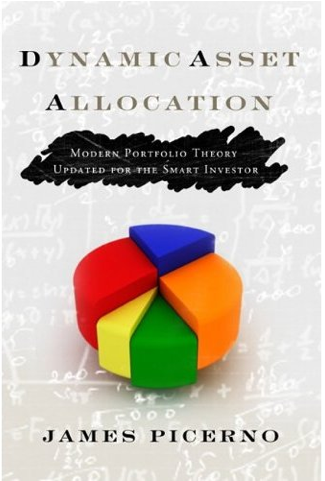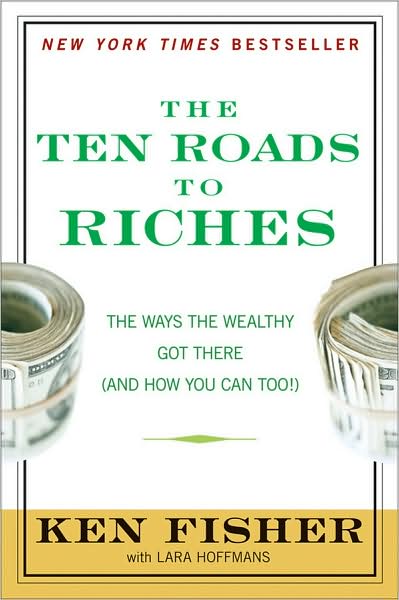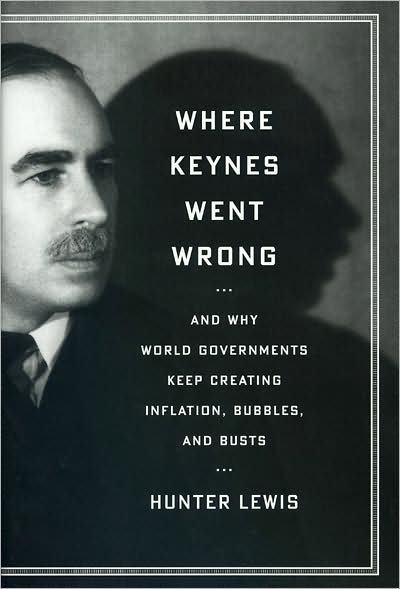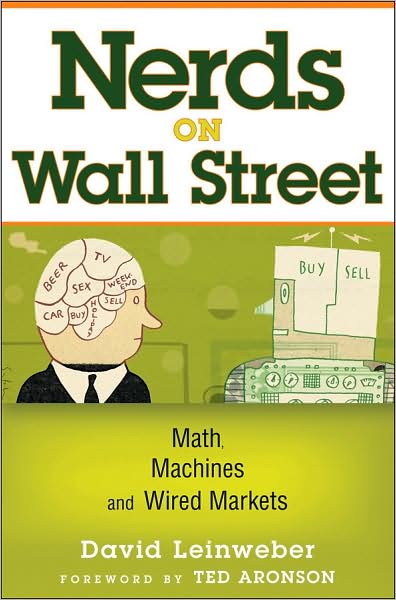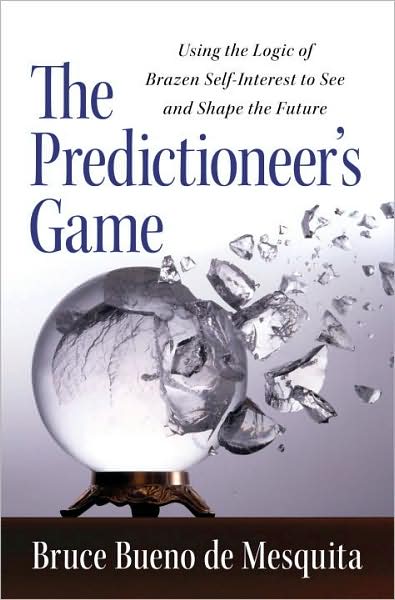
Many dream of riches.? Few achieve them.? Why?? It usually involves self-denial and hard work.? It’s not that anyone can’t achieve riches, if they start young enough, but they won’t make the sacrifices to do so.? A strong education helps, but is not absolutely required.? As my old boss Eric Hovde said to his staff repeatedly, the biggest difference in success comes from the degree of effort put forth.? I would only add that working smart amplifies the effort of working hard.
Ken Fisher the billionaire asset manager, identifies the ten ways he has seen to become wealthy.? They are:
1) Build a significant business.
2) Manage a significant business.
3) Be the right hand man of a wealthy person.
4) Be a star athlete, entertainer, or one who significantly facilitates star athletes and entertainers.
5) Marry a wealthy person.
6) Be a lawyer that helps clients sue for major amounts of money on a contingency fee basis.
7) Manage a lot of Other People’s Money.
8 ) Be an inventor of something popular, a popular writer, a prominent politician, or invent an organization that a lot of people want to give money to.
9) Borrow a lot of money and speculate on property appreciation.
10) Work hard, save a lot, and invest wisely.
I think he has nailed it.? My way of summarizing it is that you have to do something that makes a lot of people happy, or at least has the potential to make a lot of people happy.? Or, make one wealthy person very happy or unhappy. Three groups — how do they work out?
A) Those who do something that makes a lot of people happy can earn a lot:
- Successful business founders, CEOs, right hand men, inventors
- Stars and their significant enablers
- Good asset managers
- Good writers
- Successful real estate developers
B) But even those that promise to do something to make people happy and fail at it can earn a lot:
- Any CEO of a big enterprise can earn a lot — at one investment firm, we used to joke that you got paid $50 million to destroy a company — it is what they had to pay to get rid of you.? Their right hand men will still prosper too, just not as much.? In the current financial crisis, that is what gores many about the large surviving firms that were bailed out.? The executives are still prospering after previous dumb decisions.? Easy to complain about it, but it is nice work if you can get it.? (Note: this is why they should not have been bailed out, especially not at the holding company level.? Government officials lie when they say they could not have done it differently.? I for one suggested alternatives ahead of time.)
- The same applies to CEOs that tweak the company’s earnings while they are there, but leave their successor in the hole.
- Many still follow stars as their stars fade; they may not make as much, but it is still a lot.? Same for writers that lose their knack.
- Many asset managers have an early period where they don’t have much in the way of assets, and their track record is great; their ideas for excess return are executable with the current assets under management [AUM].? That leads to growth in assets, until they are too big for the asset class in which they have expertise.? They become index-like, or they venture outside their circle of competence, and their track record suffers.? But AUM is high, and the fees can provide a nice income.? Assets are sticky if you don’t do too badly, and are a good salesman/storyteller.
- Politicians can make a lot of money off of contacts or giving speeches once out of office, even if they were on net harmful to the nation while in office.
- Some charities (or nonprofits like mutual insurers or credit unions) can be less than scrupulous about what managers get paid.
- The real estate speculator, the CEO, and certain investment managers can have a “Heads-I-win, Tails-you-lose” attitude.? America gives people a lot of second chances before you are permanently branded as a fraud.? It only takes one big win to make a lot for yourself, even if you destroy the well-being of others in the process.
C) Then there are those that only have to serve a few:
- The spouse of a wealthy person.
- The right hand man of a wealthy person, and
- The Trial Lawyer going after a big tort
- Serve yourself, as an ordinary person working at a job.
No one begrudges the wealth of those in group A — they have served society well.? Many begrudge the wealth of those in group B — they have not served society well.? Group C?? It depends on motives.? More later on this.
One thing is certain, though.? There aren’t many seats in each of the “roads to riches,” except for the last ordinary one, #10.? Few are founders of massive enterprises, or CEOs, or stars, or investors of must-have products or processes.? Few can serve in high office, or write best-sellers, or be able to source a lot of assets to manage.? Few can get the capital markets or banks to loan them millions, even billions.? Few get to try a lawsuit where a huge award is won.? Few get to marry rich.? Also, most succeeding have to hit their right path while young, to allow enough time for compounding their success.
It takes a lot of effort and good breaks in order to be at the top of any economic situation where there is a lot of wealth.? Even road #10, doing well at your job, saving a lot and investing wisely is tough.? Few get to become “The Millionaire Next Door,” but more achieve reasonable wealth that way than all of the rest combined.
Ken Fisher writes about all of these areas in an entertaining way, and gives practical advice on how to follow each road, including additional books to read, and techniques for getting started.? It is an ambitious and compact book weighing in at around 230 pages of text including the preface.? It is an easy, breezy read. As a bonus, in road 10, Ken Fisher shares basic investment advice for the retail investor.
More than Quibbles:
I owe a lot to Ken Fisher for advice that he gave me in Winter 2000, and though I enjoyed the book, I can’t endorse it wholeheartedly.? He is out to tell you how to do it, even in cases where there might be significant moral compromise.? He acknowledges that, but says it is a part of the game.
To me, the key question is what your motives are.? It’s one thing to enter into a risky business, offer full disclosure to all stakeholders in advance, make a best effort, and fail.? It is quite another to trick/cajole people into backing you without full knowledge, and fail.
It is one thing to try a legal case where the damages are proportionate to the harm caused, and another thing to help create disproportionate judgments. It is one thing to serve a wealthy person who asks you to do things that are ethical, and another thing to serve in things that are unethical.? Once you have fans, a privileged job, or “sticky assets,” do you start giving less than your best?? I write this as one that is himself prone to laziness when things go well.? It is a common sin that one has to fight.
Are you looking out for the best interests of those you serve, and society more broadly?? A tough question for any of us, but society itself does not do well when a dominant proportion of it does not serve for good motives.? If it gets bad enough, the society will lose legitimacy and vitality.
Finally, it is one thing to marry because you love the person, and want to give your all to your future spouse.? It is quite another thing to enter in with crossed fingers, and say, “Maybe this will work, maybe it won’t.? I will be careful to protect myself, because the odds of failure are significant.? But economically, it will work out for me either way.? I’m wealthy if we marry, whether it works or not, because the prenup will leave me well off.”
Here’s the common vow: I, (Bride/Groom), take you (Groom/Bride), to be my (wife/husband), to have and to hold from this day forward, for better or for worse, for richer, for poorer, in sickness and in health, to love and to cherish; from this day forward until death do us part. Maybe promises don’t mean much any more, but I can’t see how one marrying for money can say that with a clear conscience.
Before my wife and I married, but after we were engaged, we were at a bookstore together, and we were looking over some marriage books to find one our pastor recommended.? She found a book entitled, “Marry Rich.”? She said to me, “This is a joke book, right?”? I said, “Uh, you would be surprised at the motives some have in marriage.”? She began leafing through it, amazed at the level of greed involved.? She married her poor graduate student boyfriend anyway.? 23 years later things are still working out well for her (and me).
One final note, not from the book: greed wears people out.? It is one thing to do what you love so long as money is not the sole purpose.? But those that are greedy for gain at all costs destroy themselves, and those around them.? It is not a good trade.
With those caveats, if you want to buy the book, you can buy it here: The Ten Roads to Riches: The Ways the Wealthy Got There (And How You Can Too!) (Fisher Investments Press) .
.
Full Disclosure: I review books because I love reading books, and want to introduce others to the good books that I read, and steer them away from bad or marginal books.? Those that want to support me can enter Amazon through my site and buy stuff there.? Don?t buy what you don?t need for my sake.? I am doing fine.? But if you have a need, and Amazon meets that need, your costs are not increased if you enter Amazon through my site, and I get a commission.? Win-win.
and, Far from Random: Using Investor Behavior and Trend Analysis to Forecast Market Movement
.
; there is more logic behind it than Far from Random.)


